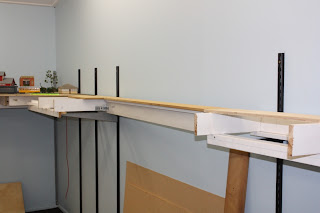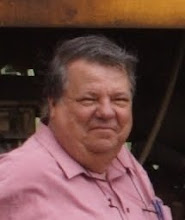Work has continued on the 14th and 15th April. Raymond and I further discussed the possible relocation of the other turnout to the loco shed road for the Mining Branch. I put forward several alternative proposals but finally we have decided to scrap making the loco shed road a through track and, instead, it will be a dead-end.
We also discussed the industrial sidings at the eastern end of the yard. Originally, we had thought that two sidings serving some sort of mineral processing plant would be suitable but then I had the idea of using part of the area for an oil depot using the Raggs to Riches Dolores Conoco Oil Depot served by a single siding with still two sidings into the mineral processing plant. Smelters and such like are usually very large complexes with big buildings and we don’t have a great deal of room. The area available is about 36 inches by 12 inches. Now as mentioned in a previous post the Conoco Oil Depot is 27 inches by 11 inches. Obviously it is not going to fit in the area available and we do not have enough space to model a complete stamp mill or smelter. Since this area is at the front of the layout we could model a few buildings of a mineral processing complex with the idea that the others are “off-scene” (off the front edge of the baseboard). So, we have decided we will stick with the mineral processing plant serviced by two sidings concept.
Saturday morning, Raymond was “on call” for work so he had to stay home while I went and did my usual Saturday morning tasks, visiting my father and then Ray Nunn at Austral Modelcraft. This time, I spent some money at Austral. We needed at least six NCE Switch-It units but could only get three. Ray would order more for us. Each Switch-It can control two Cobalt turnout motors. I then went to Jaycar at Kuraby to look at soldering stations. The digital soldering station we have was supplied by Dick Smith (Model 137). Dick Smith retailers had advised us that they no longer supplied parts and hadn’t sold soldering stations for about 8 months or so. We had been trying various electronics dealers on line including one suggested to me located in Perth to source new soldering tips for our soldering station to no avail. Raymond did find a dealer in the UK who apparently has suitable tips but they will not send any products to Australia. I found a Goot (Japanese made) soldering station at Jaycar but at $299 I decided to do a bit more “window shopping” on line before I committed that much money. I then went to Bunnings and bought a new model Bosch battery drill. We already had a Bosch 18-volt battery drill purchased some five or six years ago. Like the new one it had come with two batteries so you could charge one battery while still being able to use the drill using the other. However, the early model drill had old style batteries which if you charge them incorrectly the battery will fail and we had already ruined one battery as it would not now accept a re-charge. The new drill uses Lithium-Ion batteries which are much more efficient and forgiving. It is smaller and lighter, and has a much greater torque than the original drill and even has a very strong LED light which shines onto the area you are drilling/screwing – very useful when you are working under the layout.
 The new drill on the left is smaller and much lighter yet it is more powerful than the older drill on the right.
The new drill on the left is smaller and much lighter yet it is more powerful than the older drill on the right.
When I arrived back home, I found Raymond had installed some more of the Cobalt turnout motors and had finished installing the one over the L-Girder which had caused him so much frustration over the previous weekend.
During Saturday afternoon, Raymond had a few issues he had to sort out for his work while I did some work in The Shed on the layout.
You will have seen photographs in earlier posts of the large gap along the rear (western) wall of the shed where I intend to build a “high” trestle which will meld into the scene on the lower deck where it is intended to have the lower track crossing a river on a small trestle in a canyon like scene. It will be some time before we can get back to building the lower deck and are consequently able to build the “high” trestle for the upper track. We also need to be mindful that the air-conditioning unit is to be installed almost directly above this space and we need to allow access for the installer. However, even considering these constraints, we did not want to prevent the operation of trains around the upper level of the layout waiting for the lower level to be built.
With this in mind I built a single section of L-Girder which would bridge the 5 ft gap in this section. The L-Girder is strong enough not to need any supports other than at either end and would even carry the weight of a 5 kg MMI die-cast locomotive. This section was installed during the afternoon and everything is now ready to lay track around the back end of the shed to join up the station yards on the left-hand (Southern) and right-hand (Northern) sides of The Shed.
 The 5 ft, wide gap joining the original yard along the left-hand wall with the new yard on the right-hand wall has been temporarily bridged by this L-Girder section.
The 5 ft, wide gap joining the original yard along the left-hand wall with the new yard on the right-hand wall has been temporarily bridged by this L-Girder section.
 The 5 ft gap where a future "high" trestle bridge will be built.
The 5 ft gap where a future "high" trestle bridge will be built.
 Looking along the track-bed towards the original yard on the southern side of the shed.
Looking along the track-bed towards the original yard on the southern side of the shed.In between his duties for his work, Raymond installed a few more of the Cobalt turnout motors.
So far Sunday has not started well. Raymond had a sleepless night as he has been suffering for quite some time from very severe headaches caused by a nerve near his left ear. He has some special pain killers to take but they usually take a while to have any effect and in the meantime he needs to rest.
I set to and laid the track starting from the western end of the new station yard on the right-hand side (Northern) side of The Shed and had it all laid except for a short piece to connect to the original station yard on the southern side of The Shed. Raymond came in and tells me he wants to solder power supply wires to connect to the Main Bus to the track on the right-hand side of the “High” Bridge. Oh well! I said that we should have lunch and pull up the track to install the wires and relay it after lunch.
 The track is now laid. Looking along the newly laid track towards the northern side of the shed.
The track is now laid. Looking along the newly laid track towards the northern side of the shed.
As soon as I had had lunch and a hot cup of coffee to settle my nerves, I pulled up the track that needed power supply wiring. Raymond soldered the required wires when he came back into The Shed and I then relaid all the track again. Now to test it.
The honour of being the first locomotive to operate over the new track as far as the first turnout on the northern side of The Shed fell to D&RGW K-28 Class No.470. It ran perfectly. Raymond ran it backwards and forwards a couple of times while I took some photographs.
 D&RGW K-28 No.470 is the first loco to pass over the new track.
D&RGW K-28 No.470 is the first loco to pass over the new track.
 No.470 at the current limit of track power just before entering the new yard layout.
No.470 at the current limit of track power just before entering the new yard layout.
Next, Raymond tested a Porter 0-4-2ST with some four-wheel work wagons behind. Again more photos. Raymond’s face had a broad grin – he was pleased and I was pleased too.
 A Porter 0-4-2T with a string of 4-wheel work wagons tests out the new track,
A Porter 0-4-2T with a string of 4-wheel work wagons tests out the new track,
 The Porter 0-4-2T stands at the end of the powered track. We have yet to run the Bus wires to continue the power further.
The Porter 0-4-2T stands at the end of the powered track. We have yet to run the Bus wires to continue the power further.
In between all of this over the past two days we have been putting out rubbish for the City Council’s Kerbside Clean-up which is due to be collected this week. The Pergola area is starting to look less cluttered.









































